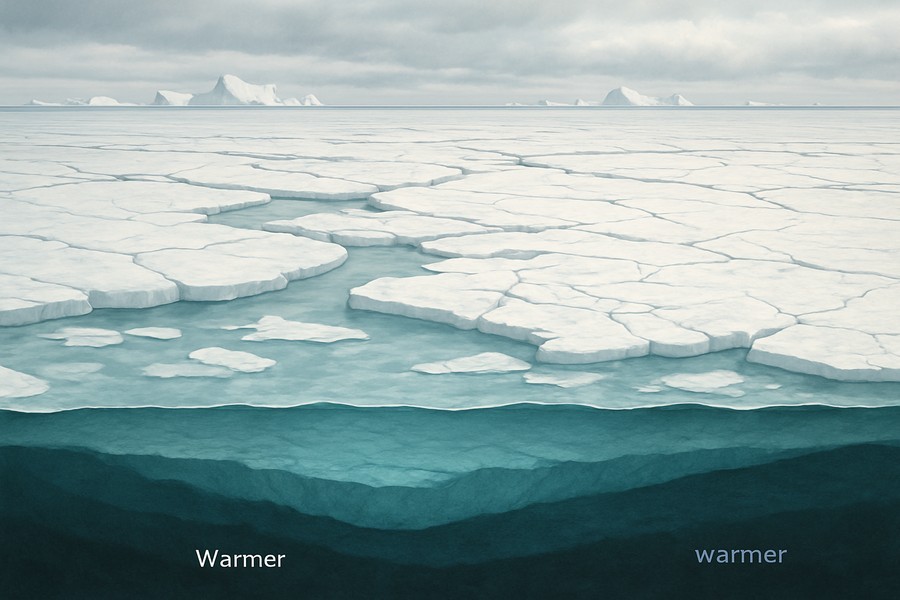
Future of Antarctic Sea Ice Tied to Ocean Layering
The future of the Antarctic sea ice, which has been experiencing notable decreases since 2014, is strongly linked to the stratification of the Southern Ocean and our carbon dioxide emissions. This is the conclusion of a new study that delves into the critical role of ocean layering in determining the possibility of sea ice recovery.
Understanding Ocean Stratification
Researchers have discovered that the thickness and stability of ocean layers play a crucial role in the potential recovery of sea ice. This refers to how the lighter, colder surface water lies above the warmer, denser, and saltier water underneath. When the ocean stratification is strong, the surface and deeper layers of the ocean remain separated, trapping heat near the surface, which can hinder ice formation and even cause ice to melt from below.
Scientists have been running climate model experiments to understand the effects of different levels of ocean stratification around Antarctica under various future carbon dioxide emission scenarios. They wanted to see under what conditions the decrease in Antarctic sea ice could be reversed, or if there are points of no return where recovery becomes challenging or extremely slow.
The Consequences of Strong Stratification
These experiments have shown that the stronger the initial stratification during high atmospheric carbon dioxide levels, the more heat was trapped in the surface ocean layer. This heat wasn't mixed downward, which led to faster sea ice melting. This melting further enhanced ocean stratification, resulting in additional sea ice loss, thus creating a vicious cycle, even when carbon dioxide emissions are cut down.
The models suggested that even if by the year 2129, carbon dioxide concentrations are restored to levels before the industrial revolution, the sea ice area would still be 1.4 million km2 less than its pre-industrial state, and would decline a further 0.2 million km2 by 2189. This indicates that changes in Antarctic sea ice lag behind carbon dioxide forcing, and the ocean continues to absorb heat induced by greenhouse gases for a considerable amount of time.
The Hope for Sea Ice Recovery
On the other hand, the models also showed that weaker initial ocean stratification could help the sea ice recover under various emissions reduction scenarios. This is because heat was stored at deeper depths or mixed downwards, cooling the surface and promoting ice formation, or at the very least, deterring melt.
However, it's important to note that stratification is changing due to factors like sea ice transport, meltwater, precipitation, and wind patterns. These changes can affect salinity and temperature profiles, which can impact stratification. Therefore, timing is crucial. If stratification remains weaker for a long enough period while we control atmospheric carbon dioxide levels, there is hope. But if the ocean's layering strengthens too much too soon, we may enter a phase where loss accelerates and recovery becomes difficult.
More Than Just Ice
The issue of Antarctic sea ice is not just about the ice itself. It affects the global climate, ocean circulation, ecosystems, and sea level. For instance, less ice means more open water in the summer, which absorbs more solar energy and further warms the ocean. Warmer surface waters can speed up the melting of ice shelves from below, leading to sea level rise. Sea ice also supports specialized ecosystems, so its loss threatens the organisms that depend on it.
To make better predictions, the researchers are calling for improved observations of stratification involving more high-resolution measurements of subsurface temperature and salinity around Antarctica. They also recommend better monitoring of meltwater fluxes, winds, and ocean-atmosphere interactions. In addition, they urge for continued efforts to refine models to better resolve vertical mixing processes. They believe that both policymakers and climate modelers should view stratification as a key factor in the future of Antarctic sea ice.
Ultimately, the team believes that reversing sea ice loss is possible, but probably only if significant carbon dioxide reductions occur sooner rather than later, and if stratification buffers warmer surface and cooler deep waters.
